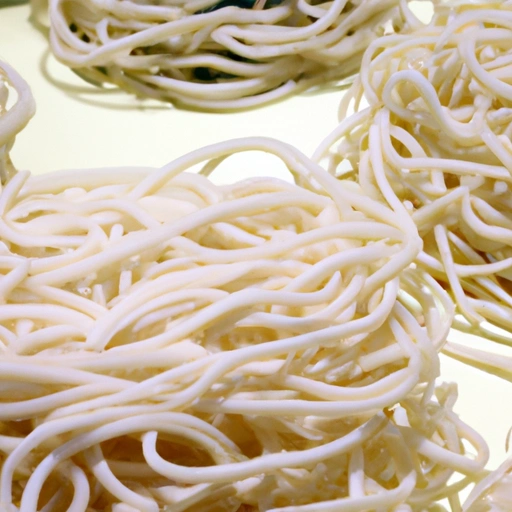Chinese Noodles
Description

Chinese noodles are a staple in Asian cuisine with a versatility that has made them a beloved ingredient worldwide. They come in numerous shapes, sizes, and textures, and are made from a variety of ingredients including wheat flour, rice flour, and mung bean starch. Typically, Chinese noodles can be found dry or fresh and are known for their ability to absorb flavors, making them perfect for a plethora of dishes from soups to stir-fries.
Common uses
Chinese noodles are commonly used in a variety of dishes. They are a fundamental component in traditional Chinese recipes such as Chow Mein and Lo Mein, and are equally at home in Thai dishes like Pad Thai, or Vietnamese Pho. Whether served in a broth, stir-fried with vegetables and protein, or simply dressed with a sauce, Chinese noodles provide a satisfying and adaptable base for countless recipes.
Nutritional value
Calories
A typical serving of cooked Chinese noodles (1 cup, approximately 140g) contains about 200 calories.
Protein
Chinese noodles offer about 7 grams of protein per serving (1 cup).
Fat
They are relatively low in fat, with around 2 grams per serving (1 cup).
Carbohydrates
Carbohydrates are the primary macronutrient in Chinese noodles, with a serving containing about 40 grams.
Vitamins
Depending on the type of flour used, some Chinese noodles can be a source of B-complex vitamins.
Minerals
They may also contain minerals such as iron and selenium, particularly if they are made from whole grains.
Health benefits
Chinese noodles can be part of a balanced diet providing a source of energy from carbohydrates. When made from whole grains, they offer more fiber for digestive health. The B vitamins in wheat-based noodles help in energy metabolism, while the protein supports muscle repair and growth.
Potential risks
For individuals with gluten intolerance or celiac disease, consumption of wheat-based Chinese noodles can cause health issues. Moreover, noodles can be high in sodium, especially when prepared with soy sauce or other salty ingredients, which can contribute to high blood pressure if consumed in excess.
Common recipes
Chinese noodles are integral to recipes like Beef Chow Fun, Dan Dan Noodles, and Singapore Noodles. They're also commonly used in various soups and salads.
Cooking methods
The cooking methods for Chinese noodles include boiling, stir-frying, deep-frying, and steaming, allowing for a wide range of textures from soft to crispy.
Pairing with other ingredients
Chinese noodles pair well with a variety of ingredients including soy sauce, oyster sauce, sesame oil, fresh herbs, and an assortment of meats and vegetables.
Summary
Chinese noodles are an incredibly diverse and adaptable food ingredient that has made its way into the hearts and kitchens of people worldwide. Whether you're using Asian, American, or European units in your recipes, these noodles provide a delicious foundation for a multitude of dishes. They carry with them a rich history, nutritional benefits, and the potential for culinary creativity, making them a must-try for any food enthusiast.